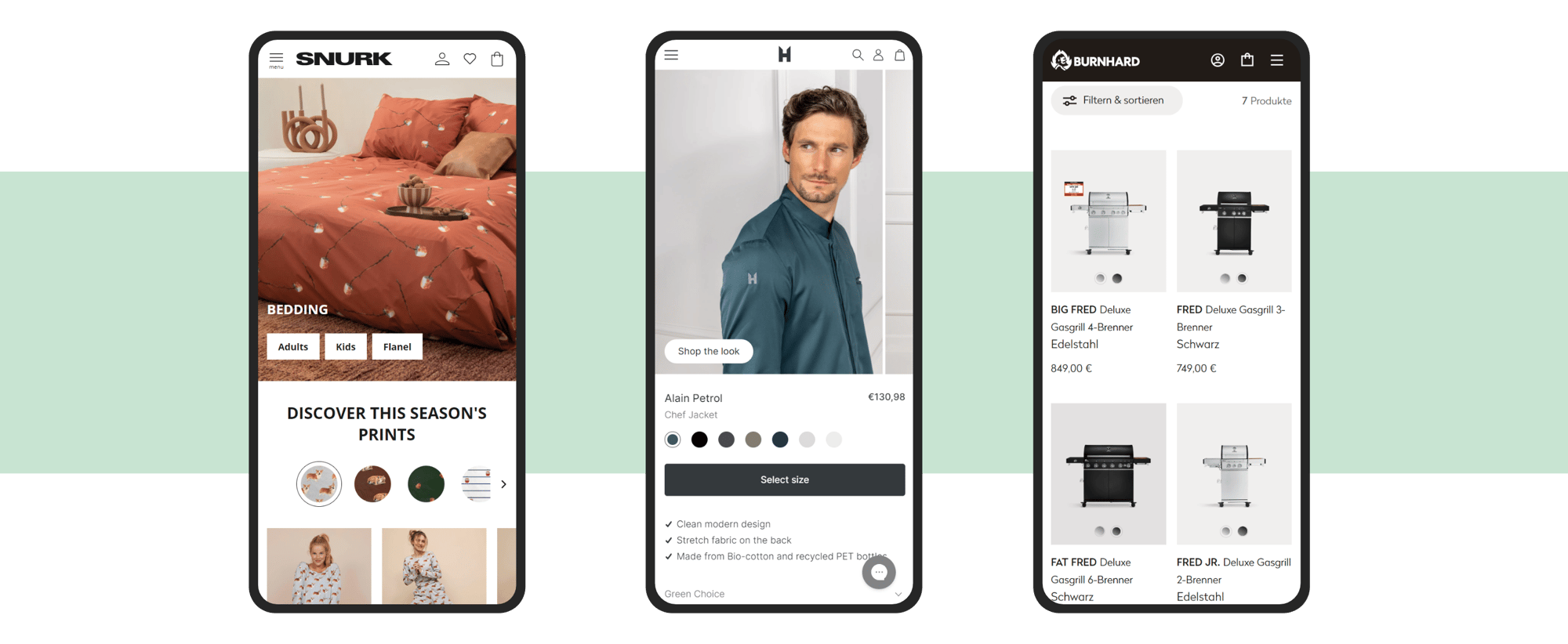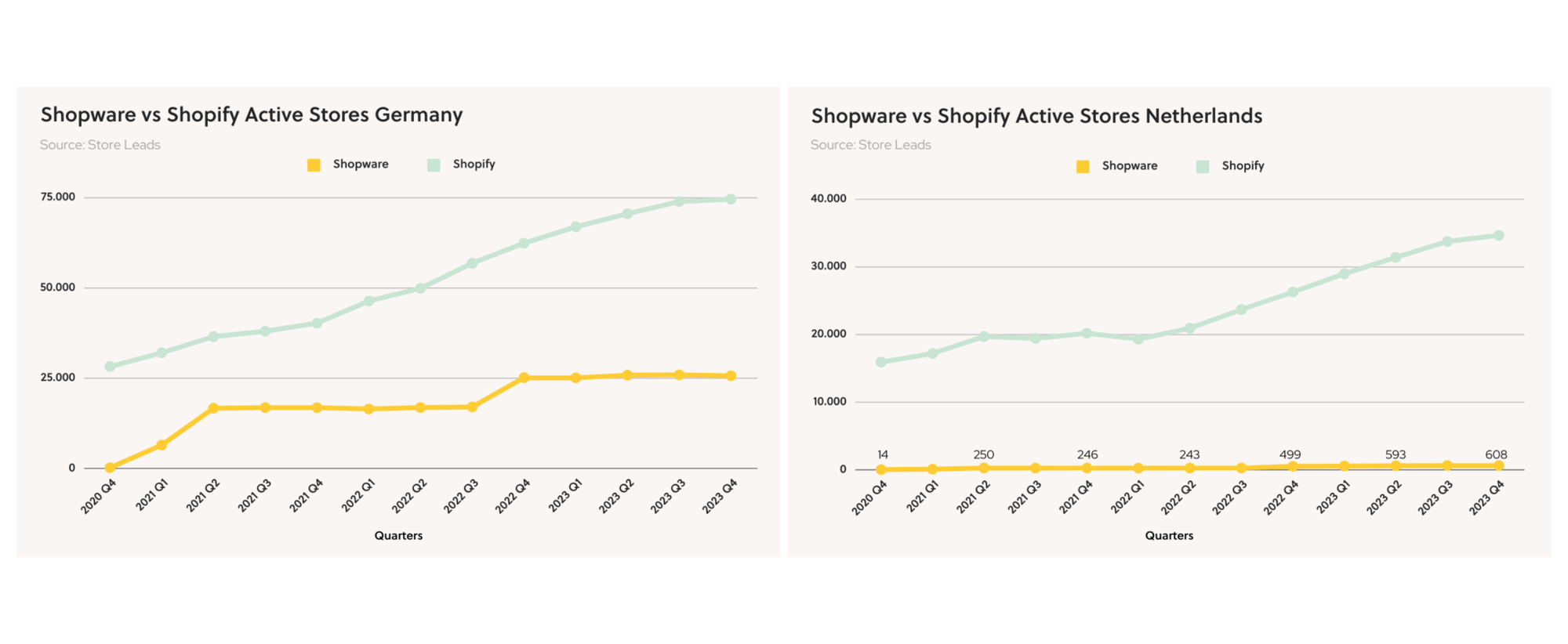The pain points of Shopware 5
An EOL, apart from being a huge nuisance to all users of a platform, often presents a big opportunity as well: the chance to find something better and regain momentum. Although many brands worry about a migration, with proper planning, the right choice of platform and the right partner it can be an almost liberating experience.
Hence, it really pays off to start the process as early as possible, instead of waiting until there is no other choice. During and after a successful migration, replatforming brands often discover how much platform frustration they have been storing over the years - and how much it was holding them back. At Code, we hear these four pain points most often.
1. Shopware is too development-heavy
Like other non-SaaS and/or self-hosted platforms, such as Magento, Shopware needs a lot of development and maintenance - especially compared to Shopify’s SaaS solution. Because Shopware’s core is relatively limited in terms of functionality, brands on the platform can’t do without third-party functionality, and/or have to resort to extensive customization. Of course, all of these added features have to be integrated, tested, maintained and updated every time Shopware is updated.
→ Read more about the benefits of a SaaS platform here…
→ … and about the advantages of Shopify here
For Peggy van Neer, founder of the Dutch bedding brand SNURK, this was a recurring frustration. “When we moved to Shopware 5 we came from a self-built store. Back then I wanted a platform because I thought it would be plug & play. But it turned out Shopware only covered the basics, and we still had to do a lot of work ourselves. That was a bit of a deception.”
German BBQ brand BURNHARD had a similar experience. They solved it with heavy customization and a large in-house IT department - but sacrificed any room to grow in the process. Minh Gerritsen, Team Lead CRM & Webshop at BURNHARD, recalls: “We have very specific requirements because of the type of products that we sell: gas grills, smokers and pizza ovens with many technical specs. Hence, we needed lots of customization in Shopware, but these custom features could not be updated. So it was clear we couldn’t grow anymore with that setup, even before the EOL.”
2. Shopware is expensive
All that development and maintenance comes at a price, of course. To get the features they need, brands on Shopware have to either partner up with a Shopware agency, or assemble their own IT team. Both options take a heavy toll on their budgets - which are already burdened with Shopware’s hosting requirements.
For Peggy van Neer, this was another deception. “I thought Shopware would be quite affordable, but when we added it all up it was a lot more expensive than it seemed at first. We needed apps for everything, which all charged a fee of course. We also struggled with server capacity: our Shopware agency told us that we needed a more powerful, more expensive server, which we got - and then the site still went down. No matter how much money we threw at it, it didn’t work.”
An added money drain is Shopware’s suboptimal user friendliness, which causes employees working with the platform to waste a lot of time. The ‘Shopware way of doing things’ didn’t make much sense to BURNHARD’s employees, for instance: “Things like reporting and search were very … in German we would say ‘verschachtelt’. The backend was a mess, it was hard to find things because it was all nested, a box in a box in a box. With Shopify Plus we no longer need a large team to operate, which has many advantages for us.”
→ Get insight into the costs of a Shopify online store for your brand. Try our TCO calculator for a personalized calculation, including Shopify fees, Apps and (ongoing) store development.
3. Shopware’s ecosystem is limited
Brands who rely on Shopware’s network of agencies might run into a capacity problem, especially at busy times when Shopware releases an update or announces an EOL. For SNURK, a Dutch brand, this presented an issue. “There aren’t that many Shopware agencies in the Netherlands, and when they’re busy you’re not being serviced. When you reach out to the Shopware headquarters in Germany about this, they usually just refer you back to your agency. Sometimes it felt like resellers had priority over clients.”
In addition, Shopware’s relatively limited development capacity - especially compared to Shopify, with its army of 4.000+ devs - also hampers the platform’s general momentum, as the German cosmetics brand Santaverde discovered. When COVID hit, Santaverde needed to reinvent itself overnight as a D2C brand to stay in business. Having a system that easily integrates with external parties was crucial.
CEO Heiko Hintze realized that Shopware 5 wasn’t the right platform to do this with. “The first lockdown instantly showed us how important our own online business was. So we started looking for a solution that would enable us to meet customer requirements quickly and build a relationship with our customers directly. Shopify offers us exactly this.”
4. Servers crashing during BFCM
Practically all Shopware users Code migrated so far had big problems during periods of high traffic, such as Black Friday. Hence, a major milestone after their migration to Shopify is a crash-free, highly successful BFCM.
Both SNURK and BURNHARD launched their new Shopify sites just before BFCM 2023, and were amazed. Peggy van Neer reports: “For the first time in three years, the site didn’t crash when we gave our VIP customers early access to Black Friday deals - which resulted in a 25% higher turnover! That also drove home to us how much revenue we’ve been missing because of the server crashing all the time.”
BURNHARD reports similar successes: “BFCM sales were really good for us this year. This kind of result wouldn’t have been possible with the old platform, because the hosting crashed a lot.”

Why Shopware 6 does not convince
Most of our clients migrated from Shopware 5 to Shopify, and weren’t very eager to switch to Shopware 6 because of all the reasons mentioned above. An exception is Dutch brand Le Nouveau Chef: about three years ago they left WooCommerce and replatformed to Shopware 6. Although they were very interested in Shopify, they decided that Shopify’s B2B solution at the time did not satisfy their requirements.
As soon as Le Nouveau Chef found out about Shopify’s much improved set of B2B tools, early 2023, they left Shopware 6 for Shopify Plus after all. What motivated this switch? Senior Brand Manager Ylmar Haring and E-Commerce Specialist Raymond Weijers explain: “Development was definitely an issue. Since we were one of the first Shopware 6 users we got all the teething problems. We had to get basic tools developed that were available out-of-the-box in other platforms."
Since they both run their own webshops on Shopify, they knew they wanted that kind of user-friendliness for Le Nouveau Chef as well. “Shopify has the most complete ecosystem, too, a controlled environment. When there’s an update nothing goes wrong, and new features can be live within a week without anything crashing.”
What Shopify has to offer
On all the pain points mentioned above, Shopify scores a lot better than Shopware. Having completed their migration, how do these four brands feel about Shopify’s performance? In addition to the reduced development load, the lower costs, the cutting-edge ecosystem, and the total absence of crashes, here are a few things they love most about their new platform:
Immediate ROI
As you saw above, SNURK and BURNHARD report being very impressed with their BFCM results - the absence of crashes alone already made a huge difference. Even more remarkable was the fact that both these stores had only been launched a few weeks before.
Just like SNURK and BURNHARD, Le Nouveau Chef took their new Shopify store online in October 2023 - and just like them, they saw positive results almost immediately. “Our revenue is up, conversion is up, AOV is up, and our SEA agency is happy with Shopify because it integrates so much better with Google. Our revenue for November 2023 is already higher than it was for November 2022, and the month isn’t even over yet. What makes it even more impressive is that we had a really good year in 2022, with restaurants reopening after the COVID lockdowns, so to top this in our second month on Shopify is amazing.”
Extreme ease of use
Another recurring theme we hear at Code is about Shopify’s extreme user friendliness. For Peggy van Neer, it felt like a dream finally come true. After Shopware’s EOL was announced, she was irresistibly drawn to Shopify: “That kind of efficiency and user friendliness was what I had been looking for all along. Our e-commerce manager once compared Shopify to Apple, and all other platforms to Android. It’s a closed system, but everything that is on offer within that system simply works.””
At Le Nouveau Chef, Shopify’s ease of use was a major reason why they left Shopware 6 after only three years. E-Commerce Specialist Raymong Weijers recalls: “[Senior Brand Manager] Ylmar and I both run our own webshop on Shopify, and we knew that we wanted that kind of user-friendliness for Le Nouveau Chef.”
Minh Gerritsen reports similar experiences. “At BURNHARD, we liked that Shopify was so out-of-the-box. Things like payments took forever and were buggy with Shopware, while in Shopify everything is very standardized. You don’t need a huge development team for it because it’s easy to use and easy to launch, and you can focus on conversion and retention instead. End-to-end testing in particular is so much easier with Shopify than it was with Shopware.”
A solid growth partner
Shopify’s innovation power is unprecedented: it's the only e-commerce platform with over 4,500 engineers continuously working on maintaining and improving the platform, headed by CEO Tobi Lütke (CEO and former developer). Every 6 months, Shopify ships a mind-boggling amount of new features.
The fact that Shopify has partner agencies like Code is also a major factor in the Shopify experience of replatforming brands. They are uniformly impressed with Code’s professional approach. “We’ve been online for over 15 years, but our IT partners never felt very professional - until now,” as Peggy van Neer puts it. “Code was a breath of fresh air for us. We received proposals from several agencies, and theirs stood out because it was so thoughtful and complete.”
Raymond Weijers and Ylmar Haring at Le Nouveau Chef concur. “We talked to the three biggest Shopify agencies in the Netherlands, but Code felt like the best fit. We had a chat with Bob [Code’s co-founder and CCO] and Mark [Code’s Director of Customer Success] and were impressed by the very specific solutions they offered to the very specific problems we brought to them.” That impression only deepened when Le Nouveau Chef kicked off their migration project with a full Discovery, Code-style. “The Discovery was wonderful, it took away a lot of our worries and cleared up any uncertainties we still had.”
→ Want to know what a Discovery is? Read more about the various phases we take our migration projects through here
What impressed BURNHARD the most was Code meeting their deadline. Minh Gerritsen was astonished: “That almost never happens. This was my fourth relaunch, and all the other ones had delays. Also impressive: during the end-to-end testing prior to launch there were no major bugs, nothing that would endanger the launch. Of course, ‘in time’ means ‘on budget’, too, which we were very happy about at BURNHARD.”
All three brands are still working with Code to further improve and optimize their online stores. Shopify Plus’s infinite scalability is meant to give a new impulse to BURNHARD’s international ambitions, while for SNURK Code’s capacities as a growth partner were a factor from the start. Peggy van Neer: “At Code they take a really broad view, not just what your store will need to launch, but also what happens after. Our small team benefits from that, it’s a partnership that we can thrive in.”
→ Read more about selling internationally with Shopify
Secure your migration with Code
Is your brand also considering to migrate away from Shopware 5 or 6, and is Shopify on your shortlist? You’re very welcome with us to hear how a move to Shopify would impact your business.
Are you already convinced Shopify is the platform for you, and are you looking for an experienced partner to guide your migration? Make sure to check out Code. From the moment we became the first official Shopify Plus Partner in the EU, we’ve been building and scaling Shopify stores and we are now considered one of the top Shopify agencies on the European mainland.
Check out our previous work to see what we can do, and get in touch

%20(1).jpg?width=1500&height=2000&name=88%20(1)%20(1).jpg)


